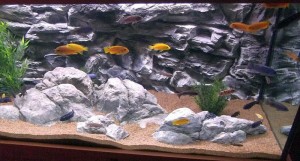Here is a simple guide to setting up your first tropical fish aquarium:
The first step is to purchase a suitable aquarium for the fish you intend to keep. Ideally, you need to purchase the largest aquarium that you can afford. A twenty or thirty gallon tank may seem large for one small fish, but in time the fish will grow and so will the other fish that you will inevitably add to the tank. Size does matter!
Fish need plenty of room to swim around in both to reduce stress and to provide them with as much oxygen as possible to their gills. The more fish you add to your tank, regardless of the size of the tank, the less oxygen the fish will be able to absorb. Therefore take some time to plan ahead on what type fish you will be keeping and size the tank.
After you purchase a suitable tank, think about where you want to showcase your fish. Positioning your aquarium is important for several reasons. Placing your tank close to a window is a bad idea. Sunlight can heat up your tank and cause the water temperatures to rise beyond what the fish can tolerate and you could find your tropical fish going belly up.
Conversely, situating the tank near an air conditioner or directly under a ceiling fan can have the opposite effect and keep the tank water too cool for tropical fish. In most areas of the country you will need a heater to keep the tank water at a comfortable temperature for your fish, so be sure there is an outlet nearby for plugging in your heater, running your filters and your tank lights.
Another consideration most people overlook is the weight of the tank when filled with water. One gallon of water weighs approximately 8.35 pounds which makes a 55 gallon tank setup with gravel, scenery, filter, hood, stand, etc. weigh in at a minimum of 460 pounds. Make sure your tank is placed in an area that can support the weight when fully set up.
Your next step in setting up your first tropical fish aquarium is to add a suitable substrate over your under gravel filter along with rocks, caves, fake or real plants, etc. for the fish to enjoy. If you are going to use an under-gravel filtration system, you need to cover it with at least an inch of gravel to provide for adequate filtration and slope it towards the front of the tank. The sloping is done to aid in siphoning out fish waste and other nasty stuff from the bottom of the tank after it has cycled.
If you use not using an under-gravel filtration system, be sure to purchase either a good canister filter or an outside filter that requires at least two filter cartridges. This minimizes the disruption of the naturally growing beneficial bacteria when your need to replace a dirty cartridge. The idea is to replace one filter cartridge at a time at different intervals so you do not disrupt the nitrogen cycle.
Your next step is to slowly fill your tank with de-chlorinated tap water. Tap water is convenient for filling freshwater aquariums but municipal water generally has high levels of chlorine, nitrites and nitrates in it which will kill tropical fish. Additionally, depending on the area that you live in, your tap water may be excessively soft or hard.
Use one of the many available chlorine removal products, along with an approved test kit to check your water hardness before adding any fish to your tank and adjust your pH accordingly. Add water to your tank slowly so you don’t disrupt the gravel, plants or other scenery. Placing a small plate on the bottom of the tank and running your water on it will minimize cloudiness.
After your tank is filled, don’t bother re-testing the water until you add fish to the tank. Pet stores stock test kits which you can purchase that test a variety of chemical levels in your tropical fish tank. Excessive amounts of ammonia, nitrates and nitrites will kill your fish and should be carefully monitored after fish have been added to the tank.
Test the water regularly to make sure that these levels stay within normal limits as your tank goes through its nitrogen cycle. The filtration system and beneficial bacteria that grow inside your tank environment will gradually rid the tank water of excess ammonia, nitrites and nitrates. Keep a keen eye on these levels for the first few weeks before and after your tank cycles out.
Accessories and additional fish can be gradually added after your tank completes it’s nitrogen cycle. Add only one or two fish at a time to prevent ammonia spikes.
Most fish love to hide in rocks or coral caves and swim through dense live or artificial plants, so it’s generally a good idea to make your tank look as much as possible like their natural surroundings.
An aquarium planted with live foliage along with an anchored wooden log will keep most South American fish healthy and happy and maintain the correct pH of the water.

An aquarium set up with plenty of open rock structure and makeshift caves will keep African cichlids healthy and happy.

Want to know more about setting up your first tropical fish aquarium? Look for additional posts on this site or visit your local bookstore to check out the numerous magazines and manuals written on how to care for your tropical fish.
.


